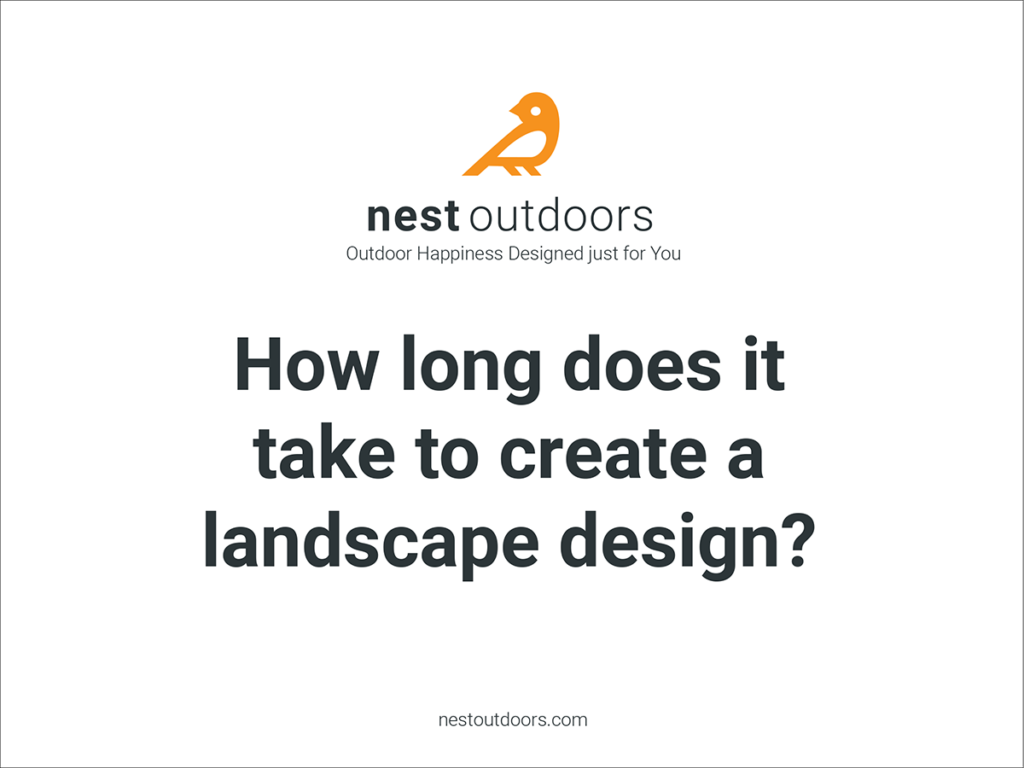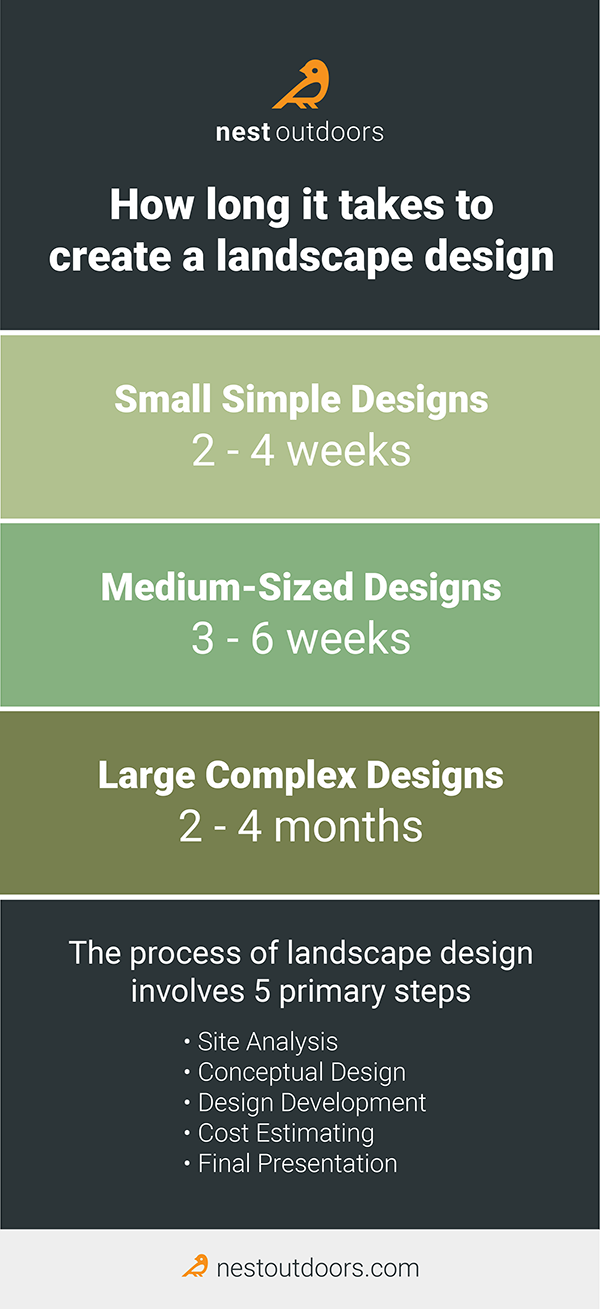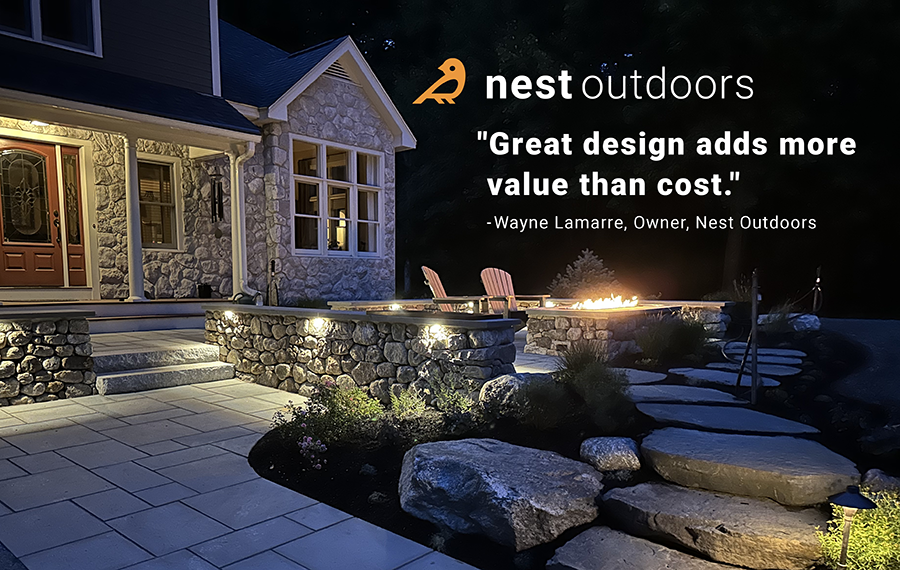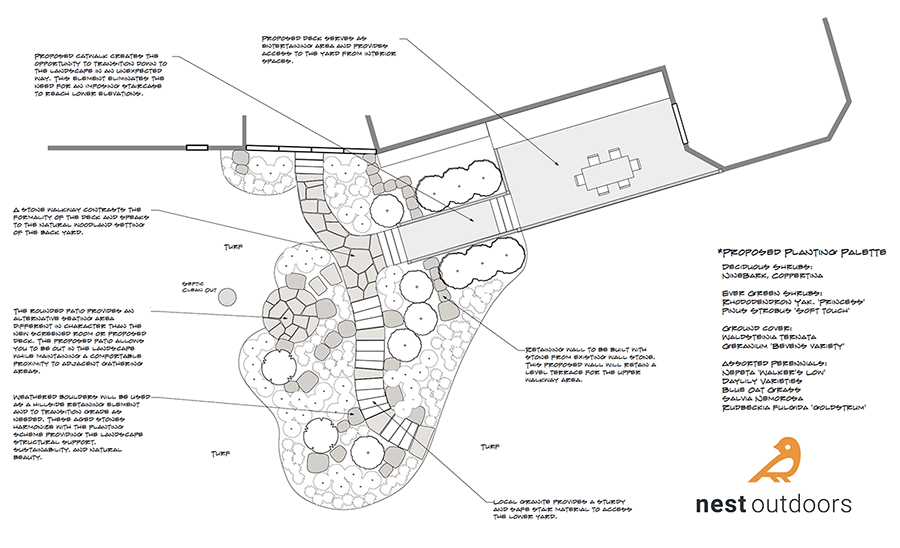How long does it take to create a landscape design?

Written by Wayne Lamarre · Last Updated October 15th, 2023
A question that crops up from time to time in our landscape design-build world is how long does it take to create a landscape design?
If you are considering a backyard makeover you're probably wondering how long it takes to create a landscape design as well. If so, you're not alone. Many homeowners have the same question before reaching out to us to design a beautiful, custom outdoor space.
Key takeaways from this landscape design trends article from Nest Outdoors:
- Smaller landscape designs are completed in several weeks, while larger ones take several months.
- The landscape design process involves several steps: site analysis, conceptual design, design development, estimating, and final presentation.
- Some factors influencing how long a design can take are in your control, while others are not.
- Busier times of the year for the designer can lead to longer design timelines.
- Your timeline and budget can also play a role in determining the design timeline.
If you've got the design timeline on your mind, we could probably guess a reason why. Here are some reasons you might be concerned with how long it will take to complete your landscape design. Do any of these sound familiar?
Reason 1: You finally decided that you arent going to look at your dull, lifeless, or borderline embarrassing landscape for one more season, and it's already spring.
Reason 2: You can't stop thinking about sipping white zinfandel in your flip-flops on the swimming pool patio with your besties and can't wait to plan the first get-together.
Reason 3: You are planning an event like a giant graduation celebration, a sweet anniversary party, or a raging birthday shindig, and your backyard just won't cut it.
No matter your reason, we get it. We have surely created designs under deadlines driven by the same motivation, as they are all highly motivating reasons to improve a subpar backyard (And you should be congratulated for getting off your duff and calling in professional help).
Landscape design timeline: Quick Answer
There are many reasons why design timelines vary, but we can state that, generally, smaller design timelines are measured in weeks, while larger design timelines are measured in months. It is always challenging to nail down an exact timeline for a creative, conceptual process that often requires review, feedback, and revisions, but the following is a general guide.
Landscape Design General Timelines:
- Smaller, simpler landscape designs take between 2-4 weeks.
- Medium-sized designs without a high degree of complexity usually take 3 - 6 weeks
- Larger or more complex landscape designs take from 2-4 months.

The best way to achieve design speed is to utilize an efficient design process.
Wayne Lamarre - Owner Nest Outdoors
Now let's dive deeper into the specifics of this this timeline question by first defining more clearly what's involved in the landscape design process and then look at the factors that could affect how long it takes to complete your design.
The process of landscape design
A landscape design is a process that creates a conceptual plan that outlines a design's elements and layout, including hardscaping features like patios, walkways, and walls, the placement of trees and plants, and other details and features such as outdoor kitchens, landscape lighting, decks, and shade structures like pergolas, and pavilions.
It's a mix of art and engineering to balance a homeowner's desires for their property with what is feasible and within the proper budget.
The process of landscape design involves 5 primary steps
- Site Analysis: This involves evaluating the existing conditions of the property, such as the topography, soil, drainage, and existing vegetation. This information is used to identify any challenges or opportunities that will influence the design.
- Conceptual Design: Based on the information gathered during the site analysis, a conceptual design is developed to establish the overall layout and function of the landscape. This may include sketches or diagrams that show the placement of elements such as walkways, patios, and plantings.
- Design Development: During this stage, the conceptual design is refined and developed into a more detailed plan. This may include the selection of specific plant species, the design of hardscaping elements, and the creation of an irrigation plan.
- Cost Estimating: Cost estimating is an essential step in the landscape design process as it helps to determine the overall budget for the project, allows you to make informed decisions about material choices, and the project's overall scope, and ensures that the project stays within a desired budget. It also helps to identify potential issues or risks early on, and make sure that the project is financially feasible. A proper cost estimate leads to a successful outcome when it comes time for construction.
- Final Presentation: The final presentation brings the process to a close and allows you to formally approve all of the conceptual decisions, materials, final size, and placement of all included features and approve the budget it will take to install your custom landscape plan.
One thing that can't be described in the above description of the landscape design process is the factors influencing how long it will take.
We love taking on outdoor living projects because we know how much the families we create them for will use and love their new backyards.
Nest Outdoors
Factors that affect how long it takes to produce a landscape design.
Different factors can affect the timeline for creating a landscape design, such as the size and complexity of your project, the availability of the designer, and the client's timeline and budget, to name a few.
Factor 1: How busy is the designer?
This is a big one. The landscape industry is seasonal in many parts of the country, leading to hectic times followed by times with less demand.
Which of these two contrasting time periods did you happen to engage your landscape designer? The answer will have a big say in how long it could take to get your design across the finish line.
Although landscape design is an organized process, it is still creative, and creativity likes a clear mind and an abundance of time. Busier times of the year usually mean that your final design will take longer than during the slower times.
Factor 2: The size of your property and the complexity of the design
A simple design with basic elements such as a lawn, a few trees, and a patio will take less time to produce than a more complex design with multiple levels, intricate hardscaping, includes an outdoor kitchen or architectural elements, and a large variety of plantings spaces.
The larger the property, the more time it will take to create a comprehensive design that incorporates all elements, especially if collaboration with other professionals is required.
Collaboration with other professionals, such as architects, engineers, and specialty contractors, can affect the timeline, as can obtaining necessary approvals and permits. An experienced designer can generally minimize these delays, but there are times when delays in responses or permit approvals are out of their hands and cause the design process to be a little longer than estimated.
Factor 3: How well has the landscape designer learned your preferences and desired investment level before developing concepts?
The process goes more smoothly when the designer performs the proper due diligence. And a smoother process usually means fewer surprises and revisions and reduces or eliminates unforeseen delays.
What does proper due diligence look like in the design process?
It means the designer has taken the time to learn about your needs, your style, or preferences and has been open about the costs associated with the landscape features you are considering from the beginning.
It is a waste of time if concepts are produced that are not aligned with your aesthetic and budget. The last thing you want to experience is being presented with designs that don't fit your vision and are way beyond what you want to invest in because both are unpleasant surprises.
Proper due diligence before working on concepts can eliminate most, if not all, unpleasant surprises, which only leaves room for all the pleasant ones.
Factor 4: YOU
Yup, a significant factor in the landscape design process is you. Your input is critical to a successful design as we need to consider and incorporate your feedback to make revisions and consolidate options into a final plan.
Timely communication is critical. On more extensive plans, it is very common to have multiple rounds of revisions. This makes your timely responses and approvals to any change an important timeline factor because it takes time to incorporate feedback and make revisions as needed. If your responses are delayed, the design will be delayed in kind.
Is it possible to speed up the design process?
It is possible to speed up the landscape design process to some extent, but it may come at the cost of quality or completeness of the final design. Here are a few ways to potentially speed up the process:
- Using preexisting surveys or site plans: Using preexisting surveys or site plans can save time in creating base plans needed for the design and design development stages.
- Simplifying the design: Simplifying the design by reducing the design scope or including fewer elements can speed up the process.
- Using technology: Most people are not used to thinking in 2D "Plan View". This is why we utilize conceptual drawing and 3D modeling when helpful to speed up the process, as it can allow for quicker revisions and more accurate visualization of the final design.
- Streamlining communication: As mentioned earlier in this article, communicating clearly, effectively, and promptly with your designer can also help speed up the process.
It's important to note that while it is possible to speed up the landscape design process, it may not always be advisable to do so. The design process should be done with the right amount of attention and care to ensure the final design is functional, beautiful, and sustainable.
So how long will it take to produce your custom landscape design? Let's start a conversation and figure it out.
Here is more helpful content with common questions answered about hiring a landscape designer
Landscape Design Timeline FAQ
The busiest time of year for landscape designers and contractors in Southern New Hampshire is between mid-March and mid-November. This is the heart of the build season, and every aspect of the landscape industry is active, which creates long, busy work days.
The best time to hire a landscape designer is as soon as you are committed to improving your property. It's best to give the design process as much time as possible to produce the best design and reach actual or preferred deadlines.
The short answer is yes. Experienced landscape designers have eliminated waste from the process and can more quickly cut to the chase and identify the critical factors for a successful design. Experienced designers are more efficient when drafting either by hand or when using CAD software and tend to produce a better final design and overall customer experience.
Quickly? Probably not. Efficiently, most definitely! If a design for a larger property doesn't involve complexities like architectural elements, complex grading, or drainage plans, it will reduce the timeline for completion. Utilizing Nest Oiutdoors's efficient landscape design process is the best way to achieve design speed.
It plays a significant role because higher-budget construction projects generally mean more time, energy, and thought that needs to be put into the process of developing the right landscape concepts. The landscape design process is also a budget development process that identifies the construction costs for everything under consideration.


About the author of this article
It's time for better outdoor living!
Contact Nest Outdoors for your landscape design

Backyard landscape design concept for a client in Hollis, New Hampshire, from Nest Outdoors
